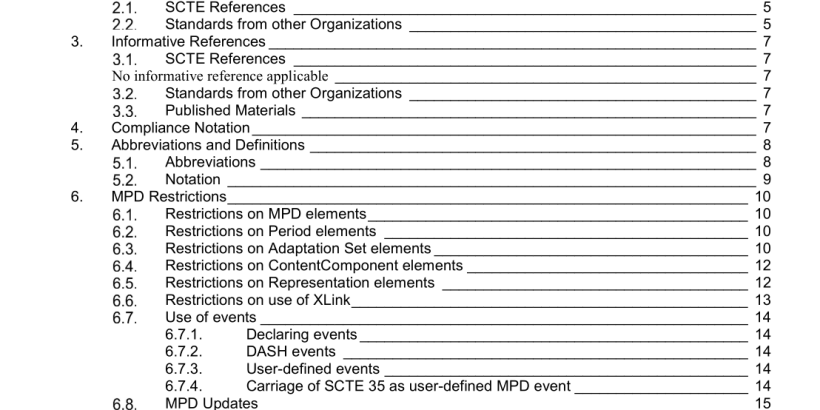ANSI SCTE 214-1-2016 pdf download.MPEG DASH for IP-Based Cable Services
ANSI/CEA-608-E, Line 21 Data Services, April 2008
ANSI/CEA-708-E, Digital Television (DTV) Closed Captioning, August 2013
ANSI/CEA-708.1, Digital Television (DTV) Closed Captioning: 3D Extensions, October 2012
IETD RFC 2141, URN Syntax, May 1997
IETF RFC 2326, Real Time Streaming Protocol (RTSP), April 1998
IETF RFC 3339, Date and Time on the Internet: Timestamps, July 2002
IETF RFC 3406, Uniform Resource Names (URN) Namespace Definition Mechanisms, October 2002
IETF RFC 3986, Uniform Resource Identifier (URI): Generic Syntax, January 2005
IETF RFC 4648, The Base16, Base32, and Base64 Data Encodings, October 2006
IETF RFC 5234, Augmented BNF for Syntax Specifications: ABNF, January 2008.
IETF RFC 6381, The ‘Codecs’ and ‘Profiles’ Parameters for ‘Bucket’ Media Types
IETF RFC 7230, Hypertext Transfer Protocol (HTTP/1.1): Message Syntax and Routing, June 2014.
IETF RFC 7231, Hypertext Transfer Protocol (HTTP/1.1): Semantics and Content, June 2014.
IETF RFC 7232, Hypertext Transfer Protocol (HTTP/1.1): Conditional Requests, June 2014.
IETF RFC 7233, Hypertext Transfer Protocol (HTTP/1.1): Range Requests, June 2014.
IETF RFC 7234, Hypertext Transfer Protocol (HTTP/1.1): Caching, June 2014.
DASH-IF Implementation Guidelines: Interoperability Points; Version 3.1, http://dashif.org/wp-
content/uploads/2015/10/DASH-IF-IOP-v3.1.pdf
4. Compliance Notation
shall This word or the adjective “required” means that the item is an absolute requirement of this specification. shall not This phrase means that the item is an absolute prohibition of this specification. forbidden This word means the value specified shall never be used. should This word or the adjective “recommended” means that there may exist valid reasons in particular circumstances to ignore this item, but the full implications should be understood and the case carefully weighted before choosing a different course. should not This phrase means that there may exist valid reasons in particular circumstances when the listed behavior is acceptable or even useful, but the full implications should be understood and the case carefully weighed before implementing any behavior described with this label. may This word or the adjective “optional” means that this item is truly optional. One vendor may choose to include the item because a particular marketplace requires it or because it enhances the product, for example; another vendor may omit the same item. deprecated Use is permissible for legacy purposes only. Deprecated features may be removed from future versions of the standard. Implementations should avoid use of deprecated features.
If Representation. SegmentList@xlink: href attribute is present, then the Representation. SegmentList@xlink: actuate attribute shall be present and have the value “onRequest”. The remote entity shall not contain the SegmentList@xlink: href attribute. This guarantees that a representation-level XLink needs to be resolved only once. Note 1: In the use case above, the expected client behavior is to select a suitable representation, and then to do XLink resolution for that representation. This operation is conceptually identical to media playlist download in HLS. Note 2: SegmentList is prohibited for ISO-BMFF-based profile, and is strongly discouraged in case of MPEG-2 TS.
If processing an event (i.e. either MPD or inband event) is essential for successful presentation, EssentialProperty with @schemeIdUri=”urn: scte: dash: essential- event: 2015″and EssentialProperty@value containing the @schemeIdUri of the essential event stream shall be present in the corresponding MPD element. If there are several event schemes, and processing one of them is sufficient, then the EssentialProperty descriptors for them shall have identical values of EssentialProperty
7.1.1. General
In many cases an audio component is not intended for a general presentation, but for a more specialized purpose (e.g., audio description for the visually impaired). Moreover, in some cases (known as“receiver mix”), two audio elementary streams need to be combined for the same service. This section defines signaling for such services. If signaling is present both in the media segments and in MPD, the two shall not contradict each other. This section uses the Role descriptor for two different purposes. In 7.1.2 Role is used to express the purpose of the audio component, while in 7.1.3 the value of the Role descriptor indicates whether an audio component represents a full or partial service.ANSI SCTE 214-1-2016 pdf download
